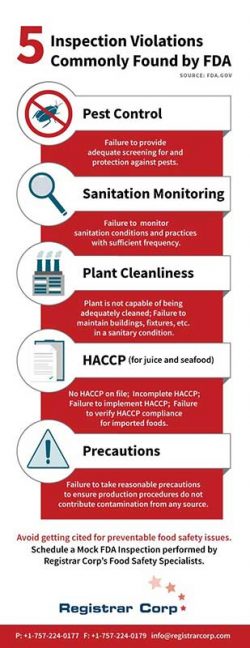The U.S. Food and Drug Administration (FDA) has released its inspectional observation data for fiscal 2017—an overview of violations cited by FDA during routine food facility inspections from October 2016 through September 2017. FDA consulting firm Registrar Corp. firm compiled the most commonly cited food safety violations:
-
Lack of Effective Pest Exclusion/Screening–The facility does not take effective measures to protect food against contamination from pests or exclude pests from food production areas.
-
Sanitation Monitoring–The facility does not monitor sanitation conditions and practices frequently enough to conform to current good manufacturing practices (CGMPs). Some factors that should be monitored include the safety of water coming into contact with food and food contact surfaces, the condition and cleanliness of food contact surfaces and the measures used to prevent cross-contamination from unsanitary objects.
-
Plant Cleanliness–The facility fails to maintain cleanliness of the premises or the facility is not constructed in a way that allows for proper sanitation or maintenance of floors, walls and ceilings.
-
HACCP Plan Implementation–A facility manufacturing seafood or juice fails to implement procedures in its HACCP plan. These may include monitoring critical control points of food hazards verifying the adequacy of the plan’s hazard control or maintaining records.
-
Reasonable Precautions–The facility does not take precautions to prevent production procedures from contaminating food. Reasonable precautions may include monitoring food processing time and temperature or monitoring manufacturing operations such as freezing or heat processing.
 These violations are nearly identical to the most common violations cited in fiscal 2016 and 2015. Food facilities should use this pattern to anticipate what areas in their daily operations may require further review before a FDA inspection.
These violations are nearly identical to the most common violations cited in fiscal 2016 and 2015. Food facilities should use this pattern to anticipate what areas in their daily operations may require further review before a FDA inspection.
FDA said the 2017 list is the first to include violations related to FDA’s Preventive Controls Rules and Foreign Supplier Verification Program (FSVP) Rule, both of which had compliance deadlines in 2017.
Most food facilities are now required to have implemented HACCP food safety plans and many importers are required to have FSVPs. Despite the first FSVP compliance deadline passing as recently as May 2017, failure to develop an FSVP was cited 108 times. With the next FSVP deadline landing in March 2018, it is probable that FSMA violations may make their way to the top next year.
Inspection violations can result in warning letters, placement on Import Alert, suspension of facility registration and other enforcement actions. With proper preparation and guidance, these food safety issues can be corrected before FDA visits a facility.
Registrar Corp.’s Food Safety specialists can conduct a mock FDA inspection of a facility to identify potential food safety violations.






